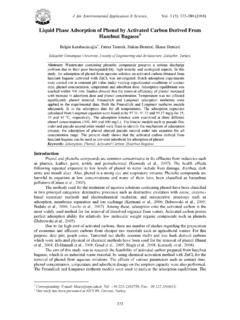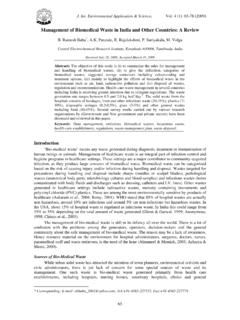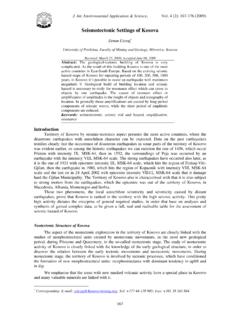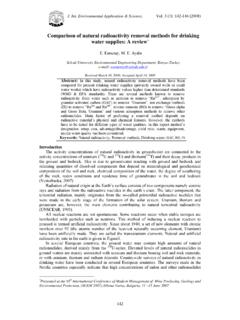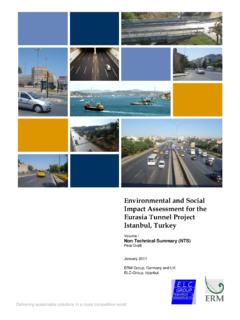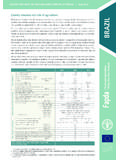Transcription of Air Oxidation of Ferrous Iron in Water - jieas.com
1 J. Int. Environmental Application & Science, Vol. 3(5): 409-414 (2008) 409 Air Oxidation of Ferrous iron in Water # Ahmet Al c lar1, , G ksel Meri 2, Fatih Akkurt3, Olcay endil4 1 Gazi University, Engineering & Architecture Faculty, Department of Chemical Engineering, 06570, Ankara, turkey ; 2 General Managership of Bank of Provinces, Ankara, turkey ; 3 Republic of turkey ministry of Environment and Forestry, Turkish State Meteorological Service, 06120, Ankara, turkey ; 4 Gazi University, Arts & Science Faculty, Department of Chemistry, 06500, Ankara, turkey Abstract: Air Oxidation of Ferrous iron in Water was studied. It was worked at three different values of pH and concentration. Oxidation was firstly carried out at stationary atmosphere. Thereafter, the experiment was successively repeated by blowing air to the solution without and with inert packing.
2 Lastly, the catalytic effect of ferric hydroxide was investigated. While the maximum yield of 86 % is catalytically achieved by blowing air at a neutral medium, the Oxidation was almost completed in an alkaline solution even at stationary atmosphere. The reaction was first order with respect to Fe2+. Keywords: iron , Water pollution, Oxidation Introduction Oxygenated Water will have only low levels of iron . The problem is most likely to develop in Water from wells with high carbonate and low oxygen. iron carbonates in an oxygen poor environment are relatively soluble and can cause high levels of dissolved iron ( ). In addition to groundwater supplies, acidic mine waters are often characterised by elevated concentrations of metal ions such as Fe2+ and Mn2+(Banks et al.)
3 , 1997). On the other hand, alkaline mine discharges are generally not that polluting in terms of metal toxicity, but can be highly ferruginous (Younger & Banwart, 1999) iron in Water does not present a health hazard. However, its presence may cause taste, staining and accumulation problems. The treatment can be performed by various techniques. Chemical Oxidation followed by filtration is the accepted method for treatment of iron when its concentration is greater than 10 ppm ( ). Oxidation of iron is achieved by addition of chemical oxidants. However, it can be easily and low cost carried out by contact with air (Wong, 1984). During Oxidation of Fe2+ salt aqueous solutions, poor soluble compounds including Fe3+ oxides are formed (Domingo et al.
4 , 1994). The composition of precipitate formed depends on numerous parameters such as temperature, pH, concentration, feed rate and anion nature (Das & Anand, 1995; Tolchev et al., 2002). For acidic discharges, lime dosing is often used to raise the pH. In this way, the rate of Oxidation and the subsequent precipitation of Fe2+ oxide minerals are increased. Aeration will also assist O2 transfer for the Oxidation of Fe2+ to Fe3+ and the subsequent removal by precipitation (Burke & Banwart, 2002). Additionally, the reaction is catalyzed by the reaction product ferric hydroxide (Sar kaya, 1990). In this work, air Oxidation of Fe2+ ions in Water is studied. Firstly, Oxidation is performed at stationary atmosphere. Thereafter, the experiment is repeated by blowing air to the solution without and with packing.
5 Additionally, the reaction is tried to catalyze by ferric hydroxide. Effects of concentration and pH on Oxidation are investigated. Experimental The Oxidation kinetics of Fe(II)(aq) species has been previously reviewed by many workers (Wehrli, 1990; Zhang et al., 1992). The stoichiometry for the overall Oxidation of Fe2+ ions by O2 is given by Eq. (1) (Burke & Banwart, 2002). O2(aq) + 4Fe2+ + 6H2O 4 FeOOH(s) + 8H+ (1) Corresponding: E-mail: Tel: +90 3122317400/2524, Fax: +90 312230 8434 #This study has been presented at BIES 08, Giresun- turkey J. Int. Environmental Application & Science, Vol. 3(5): 409-414 (2008) 410Eq. (2) gives the most commonly verified rate law for the Oxidation of Fe(II) (Davison & Seed, 1983; Tamura et al.)
6 , 1976) . It has been, however, reported that the Oxidation kinetics appear to change depending on pH, acidic compounds and ions in solution (Miles & Brezonik, 1981; Millero, 1985; Sung & Morgan, 1980), and oxygenation is greatly accelerated in the presence of surfaces (Barry et al., 1994). -d[Fe(II)]/dt=k[Fe(II)][OH-]2[O2] (2) In the light of this, it may be thought that the oxygenation is affected by numerous factors, solution pH, Ferrous ion and oxygen concentrations, and catalyzed by solid surfaces. In experiment, it was tried to study these effects. For this purpose, it was conducted at three different values of pH and concentrations of Fe2+ (Table 1). The oxidant was air. Aqueous solutions of Fe(NH4)2(SO4) were prepared as an initial reagent and the required pH value was achieved by adding NH3 or H2SO4.
7 The distilled Water used to prepare solutions was saturated to air by resting at open atmosphere for a long time prior to use. Oxidation was carried out in a batch system was used for Oxidation . The experiment was firstly made at stationary atmosphere and the solution of 100 mL was rested at 20oC in a thermostatic bath for 15 minutes. The second part of experiment was also performed as similar to the first one. Differently, it was worked at 35oC in order to study the effect of temperature. The third part experiment was conducted by blowing air to the centre of the solution in order to support the transfer of O2. Air flow rate was determined as mL/s with a flow meter. To increase the gas-liquid contact efficiency and catalyze the reaction, last studies were completed in a solution with inert packing (8 mm spherical glass bead) and Fe(OH)3 respectively.
8 For each case, variations happened on Oxidation of Fe2+ were observed. Amounts of unoxidized Fe2+ in the solution were measured with bipyridine method (Fresenius, 1988). Oxidation yields were calculated by using initial and final concentrations of Ferrous ion in the solution. The results were discussed from several points of view. Result and Discussion Reaction order can be calculated from experimental results. If concentrations of OH- ion and oxygen are kept constant, the Oxidation rate changes only depending on the concentration of Fe2+ in the solution according to the equation 2. If a logarithmic graph is drawn as oxidized amount versus concentration of Fe2+, the slope of obtained line gives the reaction order with respect to Fe2+.
9 An example graph drawn for this purpose has been shown in Fig. 1. This graph can also be formed for different conditions (Table 2). The slope of line can be calculated as from The values obtained from other graphs ranges from to by which the mean value can be found as , air Oxidation of Ferrous ion in Water is first order with respect to Fe2+. Table 1: Experimental Conditions System Batch Initial reagent Solution volume, m3 Initial concentration of Fe2+, kg m-3 pH pH adjuster Temperature of solution, oC Oxidant Operation time, sec Air flow rate, m3 s-1 Inert packing Diameter of inert packing, m Catalyst Determination method of Fe2+ Fe(NH4)2(SO4) , , 3, 7, 9 NH3 or H2SO4 20, 35 Air 900 Spherical glass Fe(OH)3 Bipyridine J.
10 Int. Environmental Application & Science, Vol. 3(5): 409-414 (2008) (Cx103) ln[(Co-C)x103] Figure 1: An example graph drawn to calculate the reaction order (pH=9, stationary atmosphere, 20oC, 15 minutes resting) Figures 2 to 5 show Oxidation yields in different cases. As seen from Fig. 2, in the case of resting in stationary atmosphere for 15 minutes, the minimum conversion of Fe2+ to Fe3+ is 96 % in basic solution while the yield is maximally 88 % in acidic medium. The yields obtained in neutral medium are around 30 % only. This result is agreed to those in the literature (Ero lu, 1984; Lorenz et al., 1988; Stauffer, 1987). Table 2. Line slopes calculated from graphs Ventilation pH Line slope Stationary atmosphere Stationary atmosphere Stationary atmosphere Air blowing Air blowing Glass packing + Air blowing Glass packing + Air blowing 3 7 9 3 7 3 7 20304050607080901002345678910pHOxidation Yield (%)Co= kg/m3Co= kg/m3Co= kg/m3 Figure 2.
